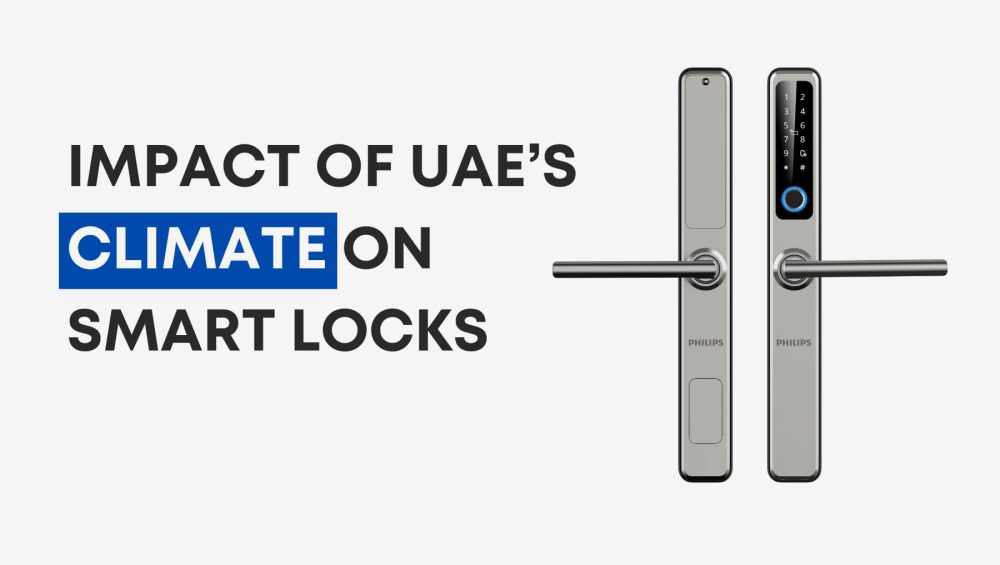The United Arab Emirates (UAE) seamlessly blends timeless traditions with futuristic architecture, creating a landscape where innovation thrives. Amid the gleaming skyscrapers and heritage sites, smart locks have emerged as crucial devices enhancing home security and convenience. However, UAE’s distinctive desert climate—characterized by extreme heat, relentless sand, and coastal humidity—poses unique challenges to smart lock technology. Let’s explore these challenges and see how Philips smart locks effectively address them.
Extreme Heat: The Silent Electronic Challenge
The Challenge:
The UAE, especially cities like Dubai and Abu Dhabi, regularly experiences temperatures soaring above 40°C (104°F). Excessive heat can significantly stress electronic components, leading to malfunctions, battery degradation, and even permanent damage to internal circuits.
Philips’ Solution:
Philips has engineered smart locks like the Philips EasyKey DDL801-5HBS with advanced thermal tolerance features, ensuring robust operation even in extreme temperatures. These models use durable materials resistant to warping and discoloration, preserving both functionality and aesthetic appeal despite prolonged sun exposure.
Sand and Dust: Small Particles, Big Problems
The Challenge:
Desert environments mean persistent threats from sand and fine dust particles. These particles can infiltrate small crevices and keypad mechanisms, eroding sensitive electronic components and causing operational inefficiencies or complete failure.
Philips’ Solution:
The Philips DDL608-5HWS smart lock features an IP65-rated enclosure that effectively prevents dust and sand infiltration. Additionally, Philips locks are designed with smooth, sealed keypad surfaces and internal protective gaskets, minimizing particle intrusion and abrasive wear.
Moisture and Humidity: The Corrosive Coastal Challenge
The Challenge:
In coastal areas like Dubai Marina or Abu Dhabi’s Corniche, high humidity combined with salty air can lead to rapid corrosion of metal components and short-circuiting of electronics within smart locks.
Philips’ Solution:
Philips smart locks utilize corrosion-resistant alloys and coatings, such as stainless steel and specialized protective layers, particularly in models like the Philips EasyKey DDL603E-5HWS. This ensures sustained functionality and durability in high-humidity coastal environments. Seals and gaskets further protect internal electronics from moisture ingress.
How Philips is Innovating for UAE’s Climate
- Enhanced Sealing Technology: Advanced weatherproofing (IP65 rating) to effectively combat moisture and dust intrusion.
- Robust Construction Materials: Using aluminum alloys and stainless steel components that withstand temperature extremes and resist corrosion.
- Smart Power Management: Improved battery performance through intelligent power management systems, even under harsh temperature fluctuations.
- Remote Maintenance and OTA Updates: Philips smart locks support over-the-air firmware updates, allowing adaptation to emerging climate challenges without requiring hardware replacements.
Is Investing in a Smart Lock Worth It in the UAE?
Advantages:
- Convenience: Quick, multiple unlocking methods—fingerprint, PIN, RFID, smartphone app.
- Enhanced Security: Real-time alerts, encrypted communication, activity logs.
- Integration with Smart Homes: Compatibility with various smart home systems, enhancing overall home automation.
- Property Value Addition: Smart locks align with UAE’s smart-city vision, enhancing property appeal and value.
Considerations:
- Environmental Resilience: Selecting locks specifically designed for UAE’s climate is crucial.
- Initial Investment: High-quality, climate-adapted smart locks may cost more upfront.
- Battery Maintenance: Heat can reduce battery life, necessitating periodic replacements or recharging.
Recommended Philips Models for UAE Conditions:
|
Model |
Ideal Use |
Climate Features |
|
Philips EasyKey DDL801-5HBS |
Family homes, villas |
Heat-resistant, IP65 rating |
|
Philips DDL608-5HWS |
External doors, gates |
Waterproof, dustproof, IP65 rating |
|
Philips DDL603E-5HWS |
Apartments, coastal properties |
Corrosion-resistant, durable casing |
Final Thoughts: Built to Thrive in the UAE
The UAE’s challenging climate demands smart lock solutions that are more than just innovative—they must be resilient. Philips smart locks exemplify the balance between cutting-edge technology, practical functionality, and weatherproof durability. Investing in these climate-adaptive smart locks ensures not only convenience and security but also long-lasting performance in one of the world’s most demanding environments.



